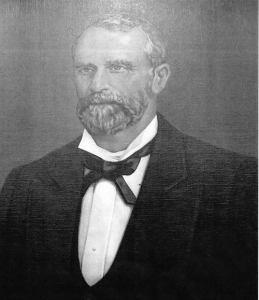
Fletcher Summerfield Stockdale, for whom the present city of Stockdale in Wilson County was named, served briefly as governor of the state of Texas in the final days of the Confederacy. Stockdale was born in Russellville, Kentucky, in 1823 or 1825; he studied law and was admitted to the Kentucky Bar. He came to Texas in 1846 where he practiced law in Anderson, Grimes County, before moving to Indianola in Calhoun County. Most citizens of Calhoun County have been unaware of Stockdale’s connection to the county, although he had served as the county’s representative in the Texas Senate from 1857 to 1861.
Besides practicing law, Stockdale was an active politician, serving as an executive member of the 1861 Secession Convention held in Austin. During the Civil War, he was an aide to Governor Francis R. Lubbock from 1862 to 1863. His support of Texas’s secession from the Union and his subsequent service in the Confederacy likely was a contributing factor in his being denied the honor of an official portrait in the Capitol.
His tenure as governor was the shortest one in Texas gubernatorial history, in that he only served from June 12, 1865 to June 17, 1865, He became acting governor after the flight of the then Governor Pendleton Murrah to Mexico after the fall of the Confederacy. Before becoming Acting Governor, Stockdale had served as Lieutenant Governor of Texas after being elected in 1863. It was this office in which he was serving when he was called upon to serve as the Acting Governor. Stockdale served in that capacity only until Andrew J. Hamilton arrived in August of 1865, having been appointed provisional governor by President Andrew Johnson. Nevertheless, Stockdale was a member of the committee that met Hamilton, escorted him into Austin, and handed him the keys to the Texas archives and the Capitol.
When he left office, Stockdale returned to Calhoun County; he remained active in politics. At one point in his political career in 1868, he was a member of the Texas Senate and, in the Constitutional Convention of 1875, he served on the committees of judiciary and land grants; he also participated in debates on the establishment of a free public school system in Texas. Stockdale was also a delegate to several national Democratic conventions and at least one state Democratic convention.
Stockdale was also active in business and had been since he came to Indianola in 1846. In the late 1860s in Indianola, he promoted the development of a refrigerator car for shipping beef. He was also the president of the Indianola Railroad and listed as assets of over twelve miles of new track completed, two locomotives and other rolling stock, depot buildings, shops, and grounds at Indianola.
Sometime after 1873, Stockdale moved to Cuero where he practiced law and promoted the Cuero Land and Immigration Company. He lived in Cuero with his second wife, Elizabeth Schleicher, whom he married when she was 17, and with whom he had three children. His first wife, Elizabeth Pryor Bankhead Lytle, died in April, 1865, before he became governor in June. He died on February 4, 1890 and is buried in Russellville, Kentucky.
In 1946, the Texas legislature ordered a painting of a portrait of Stockdale which was then hung in the gallery of Texas governors in the Capitol. For many years, Stockdale’s portrait was not displayed in the State Capital in Austin until the persistent efforts of organized advocates resulted in that portrait being hung there and Stockdale was formally recognized as a former governor in 1846 when the Texas Legislature ordered a portrait hung in the portrait gallery.
Curiously in 2016, a senior communication studies major at Texas Christian University was arrested after he broke into the Texas Capital during the renovation of part of the building and threw the portrait from the third floor, damaging it to the tune of $10,000. Tanner Graeber was the culprit’s name although his motivation for the act has not been established. The portrait has since been restored to the gallery of portraits.
Submitted by Russell Cain
